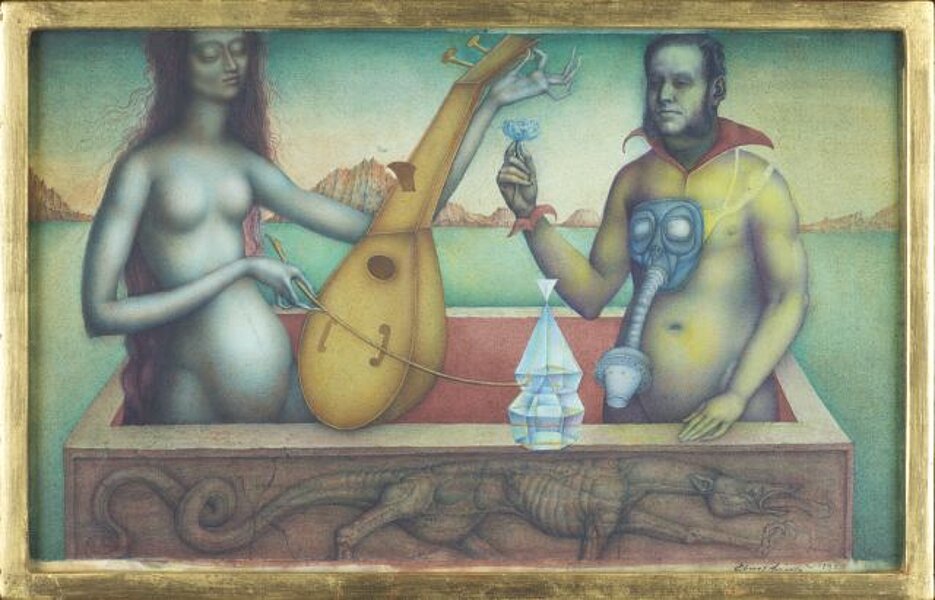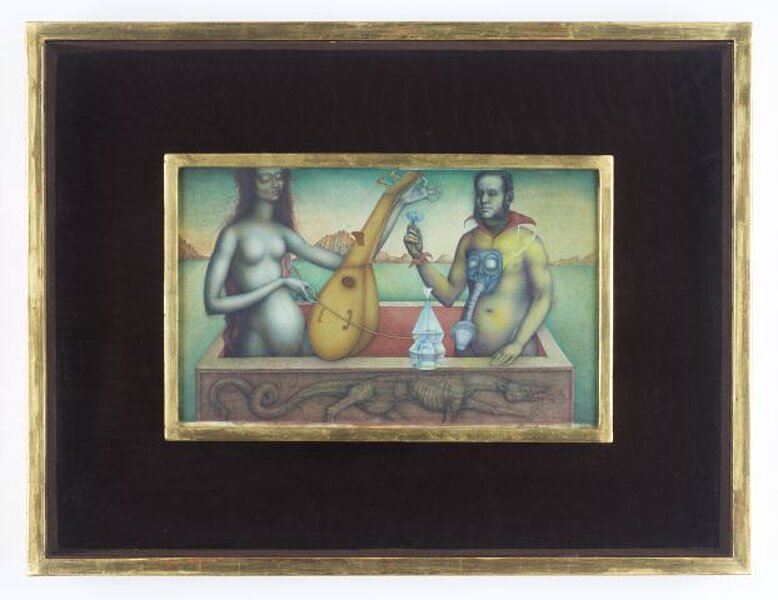
Fuchs, Ernst
Allegorie
1951
| Object description | Mixed media on paper on wood |
|---|---|
| Object category | painting |
| Dimensions |
Rahmenmaß:
height: 38,5 cm,
width: 51 cm,
depth: 6,5 cm
Objektmaß:
height: 20 cm,
width: 30 cm
|
| Year of acquisition | 1983 |
| Inventory number | B 601/0 |
| Creditline | mumok - Museum moderner Kunst Stiftung Ludwig Wien |
| Rights reference | Bildrecht, Wien |
| Further information about the person | Fuchs, Ernst [GND] | Fuchs, Ernst [ULAN] |
| Literature |
Mythos Art Club. Der Aufbruch nach 1945. Porträts. Aus der Sammlung So near so far 1947-1960 : Czech art in international sociocultural contexts |
This work by Austrian painter Ernst Fuchs is entitled “Allegory”, but it remains unclear what exactly the allegory is supposed to represent. We see a naked woman with a soft and heightened femininity reminiscent of Gothic Madonnas of the fourteenth century. She is playing what seems to be a medieval musical instrument. Beside her is a man with whiskers wearing a suit that looks like a second skin. He is holding a blue flower, a symbol of the German Romantic movement, and a gas mask is hung on his chest. These two figures are standing in a stone sarcophagus. The scene is like images of Christ risen from the tomb. The sarcophagus is decorated with a dragon relief, and there is an angular glass carafe on its wall. The background is a strange landscape with rough hills and a calm lake. The golden frame cuts of the tops of both figures’ heads, creating a disturbing effect. This mysterious painting is seen as belonging to the “Vienna school of fantastic realism,” which Ernst Fuchs founded in 1948 together with fellow students Wolfgang Hutter, Aric Brauer, Rudolf Hausner, and Anton Lehmden. This Austrian movement was close to surrealism and yet also took inspiration from old masters such as Pieter Breughel and the Italian Renaissance. In Ernst Fuchs’s work we can see motifs taken from the old masters and a precise and detailed use of painting techniques that were long forgotten. He worked with egg tempera and resin oil paints. Fuchs learned his layered painting technique by reading a standard work on the restoration of paintings. His meticulous method led to old-master style paintings with mythical and spiritual motifs. Fuchs himself said: “I was always interested in a kind of painting that shows the pictures that other people see when they are dreaming or hallucinating.” What do you think you might dream tonight?
© mumok – museum moderner kunst stiftung ludwig wien

